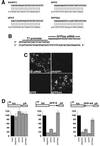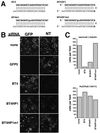RNA interference by expression of short-interfering RNAs and hairpin RNAs in mammalian cells
- PMID: 11972060
- PMCID: PMC122899
- DOI: 10.1073/pnas.092143499
RNA interference by expression of short-interfering RNAs and hairpin RNAs in mammalian cells
Abstract
Duplexes of 21-nt RNAs, known as short-interfering RNAs (siRNAs), efficiently inhibit gene expression by RNA interference (RNAi) when introduced into mammalian cells. We show that siRNAs can be synthesized by in vitro transcription with T7 RNA polymerase, providing an economical alternative to chemical synthesis of siRNAs. By using this method, we show that short hairpin siRNAs can function like siRNA duplexes to inhibit gene expression in a sequence-specific manner. Further, we find that hairpin siRNAs or siRNAs expressed from an RNA polymerase III vector based on the mouse U6 RNA promoter can effectively inhibit gene expression in mammalian cells. U6-driven hairpin siRNAs dramatically reduced the expression of a neuron-specific beta-tubulin protein during the neuronal differentiation of mouse P19 cells, demonstrating that this approach should be useful for studies of differentiation and neurogenesis. We also observe that mismatches within hairpin siRNAs can increase the strand selectivity of a hairpin siRNA, which may reduce self-targeting of vectors expressing siRNAs. Use of hairpin siRNA expression vectors for RNAi should provide a rapid and versatile method for assessing gene function in mammalian cells, and may have applications in gene therapy.
Figures




References
Publication types
MeSH terms
Substances
Grants and funding
LinkOut - more resources
Full Text Sources
Other Literature Sources
Research Materials

